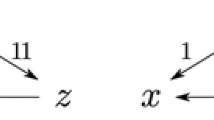One of the several topics in which Fishburn (1997, 2002) has made basic contributions involves finding maximal Condorcet Domains. In this current paper, I introduce a geometric approach that identifies all such domains and, at least for four and five alternatives, captures Fishburn's clever alternating scheme (described below), which has advanced our understanding of the area.
To explain “Condorcet Domains” and why they are of interest, start with the fact that when making decisions by comparing pairs of alternatives with majority votes, the hope is to have decisive outcomes where one candidate always is victorious when compared with any other candidate. Such a candidate is called the Condorcet winner. The attractiveness of this notion, where someone beats everyone else in head-to-head comparisons, is why the Condorcet winner remains a central concept in voting theory. For a comprehensive, modern description of the Condorcet solution concept, see Gehrlein's recent book (2006).
Preview
Unable to display preview. Download preview PDF.
Similar content being viewed by others
References
Arrow, K. (1951). Social choice and individual values. New York: Wiley.
Black, D. (1948). On the rationale of group decision-making. Journal of Political Economy, 56,23–34.
Condorcet, M. (1785). Éssai sur l'application de l'analyse a la probabilité des decisions rendues à lapluralite des voix, Paris.
Fishburn, P. (1997). Acyclic sets of linear orders. Social Choice and Welfare, 14, 113–124.
Fishburn, P. (2002). Acyclic sets of linear orders: A progress report. Social Choice and Welfare,19, 431–447.
Gaertner, W. (2001). Domain conditions in social choice theory. New York: Cambridge University Press.
Gehrlein, W. (2006). Condorcet's Paradox. Berlin: Springer.
Li, L.,&Saari, D. G. (2004). Sen's theorem: Geometric Proof. New Interpretations, IMBS working paper series. Social Choice Welfare (2008) 31, 393–413.
Monjardet, B. (2006a). Condorcet domains and distributive lattices. Workshop on Voting Theory and Preference Modeling. DIMACS-LAMSADE, Paris, October 26, 2006.
Monjardet, B. (2006b). Condorcet domains and distributive lattices, pp. 285–301, Annales du LAM-SADE, Université Paris, Daupine.
Monjardet, B. Acyclic domains of linear orders:a survey, in this volume. Saari, D. G. (1999). Explaining all three-alternative voting outcomes. Journal of Economic Theory,87, 313–355.
Saari, D. G. (2000a). Mathematical structure of voting paradoxes 1: pairwise vote. Economic Theory, 15, 1–53.
Saari, D. G. (2000b). Mathematical structure of voting paradoxes 2: positional voting. Economic Theory, 15, 55–101.
Saari, D. G. (2001a). Decisions and elections, explaining the unexpected. New York: Cambridge University Press.
Saari, D. G. (2001b)., 2001, Chaotic elections! A mathematician looks at voting. Providence, RI: American Mathematical Society.
Saari, D. G.,&Petron, A. (2006). Negative externalities and Sen's liberalism theorem. Economic Theory, 28, 265–281.
Saari, D. G.,&Sieberg, K. (2004). Are part wise comparisons reliable? Research in Engineering Design, 15, 62–71.
Sen, A. K. (1966). A possibility theorem on majority decisions, Econometrica, 34, 491–499.
Sen, A. K. (1970) The impossibility of a Paretian libera. The Journal of Political Economy, 78,152–157.
Ward, B. (1965). Majority voting and the alternative forms of public enterprise. In J. Margolis (Ed.),The Public Economy of Urban Communities (pp. 112–126). Baltimore, MD: Johns Hopkins University Press.
Author information
Authors and Affiliations
Corresponding author
Editor information
Editors and Affiliations
Rights and permissions
Copyright information
© 2009 Springer-Verlag Berlin Heidelberg
About this chapter
Cite this chapter
Saari, D.G. (2009). Condorcet Domains: A Geometric Perspective. In: Brams, S.J., Gehrlein, W.V., Roberts, F.S. (eds) The Mathematics of Preference, Choice and Order. Studies in Choice and Welfare. Springer, Berlin, Heidelberg. https://doi.org/10.1007/978-3-540-79128-7_9
Download citation
DOI: https://doi.org/10.1007/978-3-540-79128-7_9
Publisher Name: Springer, Berlin, Heidelberg
Print ISBN: 978-3-540-79127-0
Online ISBN: 978-3-540-79128-7
eBook Packages: Mathematics and StatisticsMathematics and Statistics (R0)



